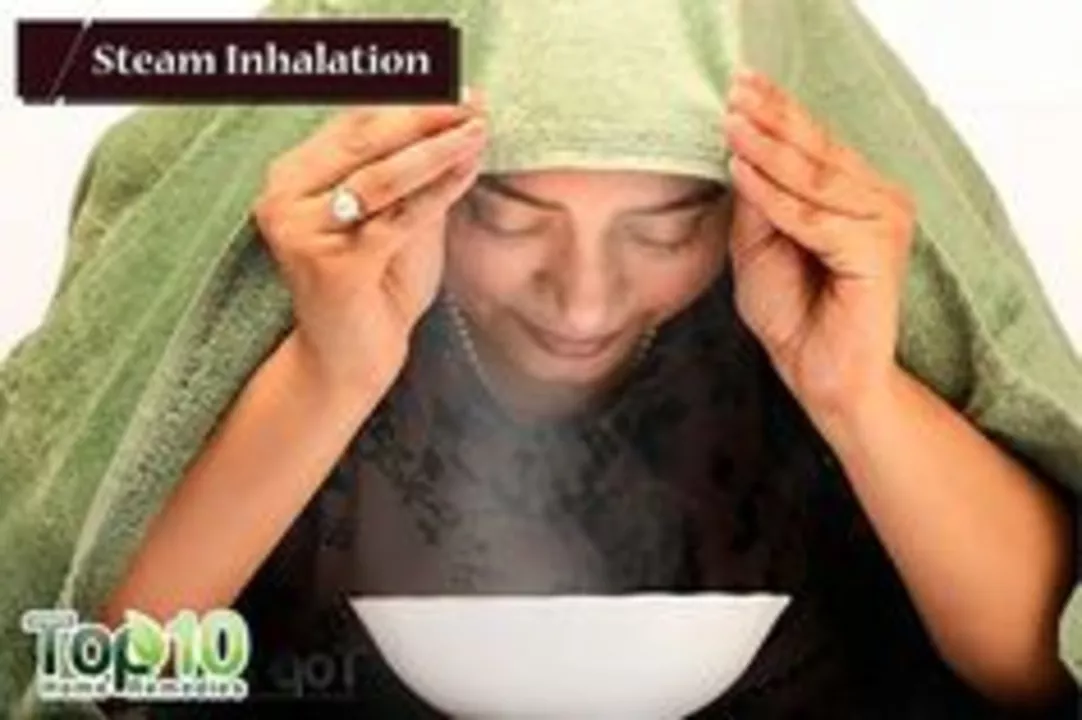Understanding Chest Congestion and Steam Inhalation
Chest congestion is a common issue we face, especially during the cold and flu season. This uncomfortable feeling in your chest is often caused by excess mucus buildup in your lungs and airways. It can lead to difficulty breathing, coughing, and wheezing. One of the most effective and natural ways to find relief from chest congestion is through steam inhalation.
Steam inhalation involves inhaling hot, moist air, which helps to break up and loosen the mucus in your airways. This makes it easier for you to cough up and expel the mucus, providing relief from the congestion. In this article, we will discuss how to use steam inhalation for chest congestion relief and explore various methods to maximize its effectiveness.
Preparing for Steam Inhalation
Before you begin your steam inhalation session, it's essential to gather all the necessary materials and prepare your space. You will need a large bowl, a towel, hot water, and any additional ingredients you choose, such as essential oils or herbs. Ensure that you have a comfortable chair to sit in and a flat surface to place the bowl on, such as a table or countertop.
Fill the bowl with hot, steaming water. Be careful not to burn yourself with the water, as it should be hot enough to produce steam but not scalding. If you're using essential oils or herbs, add a few drops or a small handful to the water now. These additions can help boost the effectiveness of the steam inhalation by providing additional therapeutic benefits.
Proper Steam Inhalation Technique
Once you have prepared your space and materials, it's time to begin the steam inhalation process. Sit comfortably in your chair and lean over the bowl of hot water. Drape the towel over your head and the bowl, creating a tent-like enclosure to trap the steam. Close your eyes and take slow, deep breaths through your nose, inhaling the steam.
It's essential to maintain a comfortable distance from the hot water to avoid burns or discomfort. If the steam feels too hot on your face, adjust your position or allow the water to cool slightly before continuing. Aim to inhale the steam for about 10-15 minutes, taking breaks if needed.
Maximizing the Benefits of Steam Inhalation
To get the most out of your steam inhalation session, there are a few tips and tricks you can follow. First, try to incorporate steam inhalation into your daily routine, especially when experiencing chest congestion. Consistent steam inhalation can help to keep your airways clear and reduce the severity of congestion.
Adding essential oils or herbs to your steam inhalation can also provide additional benefits. For example, eucalyptus oil is known for its decongestant properties, while lavender oil can help promote relaxation and reduce stress. Experiment with different oils and herbs to find the combination that works best for you and your specific needs.
Pairing Steam Inhalation with Other Remedies
While steam inhalation can provide significant relief from chest congestion, it can be even more effective when paired with other remedies. Make sure to stay well-hydrated by drinking plenty of water, which can help to thin mucus and further ease congestion. Over-the-counter expectorants and cough suppressants can also be beneficial in managing your symptoms.
In addition to these remedies, incorporating lifestyle changes such as elevating your head while sleeping and practicing good hygiene can help prevent chest congestion from worsening or recurring. Always consult with a healthcare professional before starting any new treatments or if your symptoms persist or worsen.
Understanding the Risks and Precautions
Though steam inhalation is a generally safe and natural remedy, it's important to be aware of the risks and take necessary precautions. The most significant risk associated with steam inhalation is the potential for burns from the hot water or steam. Always use caution when handling hot water and maintain a safe distance from the steam during the inhalation process.
Additionally, some individuals may have sensitivities or allergies to certain essential oils or herbs. If you experience any adverse reactions during steam inhalation, discontinue use immediately and consult with a healthcare professional. Finally, remember that steam inhalation should be used as a complementary treatment and not a replacement for professional medical care when needed.
When to Seek Professional Help
While steam inhalation can provide relief for mild to moderate chest congestion, it's crucial to recognize when professional help is needed. If your chest congestion is accompanied by a high fever, difficulty breathing, chest pain, or a persistent cough that lasts more than a few weeks, it's essential to consult with a healthcare professional.
These symptoms may indicate a more severe underlying condition, such as pneumonia or bronchitis, that requires medical attention. Additionally, if you've tried steam inhalation and other home remedies without improvement or if your symptoms worsen, seek professional help to ensure you receive the appropriate care and treatment.






jake cole
12 June 2023 - 13:49 PM
Honestly, this whole steam inhalation hype is just a marketing shtick dressed up as home‑remedy wisdom. You're basically boiling water and hoping the vapor does miracles, which is nothing more than wishful thinking. If you actually want to clear mucus, a proper humidifier or prescribed mucolytics are far more reliable.
Natalie Goldswain
13 June 2023 - 06:29 AM
i love how simple it is, just a bowl and a towel. lol tack it on some eucalypt oil and breathe easy.
khajohnsak Mankit
13 June 2023 - 23:09 PM
Steam inhalation, when considered through the prism of ancient Ayurvedic alchemy, reveals itself as a vaporous bridge between the corporeal and the etheric. The warm mist acts like a gentle tide, coaxing the obstinate phlegm to surrender its grip on the bronchi. Each inhalation is a dialogue between the lungs and the unseen currents of humidity, a subtle negotiation for freedom. By introducing aromatic botanicals such as eucalyptus or rosemary, one infuses the air with terpenes that whisper antiseptic lullabies to inflamed tissues. The physiological cascade set in motion involves vasodilation, enhanced ciliary motion, and a temporary reduction in surface tension of mucus. These micro‑mechanisms, though invisible, culminate in the macroscopic experience of easier breathing. Moreover, the ritualistic aspect of crouching over a steaming bowl engages the parasympathetic nervous system, ushering in a state of calm that mitigates the stress‑induced constriction of airways. From a philosophical standpoint, the act embodies the principle of "the middle way"-neither too hot to cause burns nor too cool to be ineffective. It reminds us that health is often found in the humble interplay of temperature, moisture, and mindful attention. While modern pharmacology offers potent expectorants, the simplicity of vapor sidesteps side‑effects that accompany synthetic compounds. Critics may dismiss it as folklore, yet countless cultures have archived steam rites as cornerstone therapies for respiratory distress. In the laboratory, studies have documented a modest but measurable increase in mucociliary clearance after a ten‑minute steamy session. Thus, the practice straddles the line between anecdotal comfort and empirical validation. For those navigating the fog of congestion, a mindful inhalation can serve as both a physical remedy and a meditative pause. In sum, steam inhalation is a modest yet elegant tool that, when wielded with awareness, can illuminate the dark corridors of chest congestion.
Pallavi G
14 June 2023 - 15:49 PM
Great rundown! If you’re going to try this, make sure the water isn’t scalding-just hot enough to produce steady steam. Drape the towel snugly so the vapor stays trapped, and breathe slowly through your nose; that helps the moisture reach deeper into the bronchi. Adding a few drops of eucalyptus or peppermint can give an extra decongestant kick, but always test a tiny amount first if you have sensitive skin. Remember to stay hydrated after the session; water will keep the mucus thin and easier to expel.
Rafael Lopez
15 June 2023 - 08:29 AM
First, ensure you have a sturdy, heat‑proof bowl, and second, use water that is hot-but not boiling-to avoid burns, and third, position the towel securely over your head and the bowl to create a proper steam chamber, and finally, inhale slowly, allowing the warm, moist air to travel deep into your respiratory tract, which can help loosen mucus and promote clearer breathing.
Craig Mascarenhas
16 June 2023 - 01:09 AM
One must consider that the promotion of steam inhalation may serve larger agendas; the push for simple home remedies could divert attention from pharmaceutical interests while subtly encouraging dependence on low‑cost interventions that nonetheless keep populations compliant.
aarsha jayan
16 June 2023 - 17:49 PM
Hey there! 🌿 If you’re adding herbs, thyme and sage work wonders together, giving a soothing aroma that feels like a forest hug for your lungs. Just sprinkle a handful into the hot water, watch the steam swirl, and let the natural goodness do its magic.
Rita Joseph
17 June 2023 - 10:29 AM
I’ve found that pairing steam inhalation with a generous glass of warm ginger tea amplifies the soothing effect; the ginger’s anti‑inflammatory properties complement the moisture, and together they create a comforting routine that’s both tasty and therapeutic.
abhi sharma
18 June 2023 - 03:09 AM
Yeah, because breathing hot water vapor totally beats a proper doctor’s visit.
mas aly
18 June 2023 - 19:49 PM
I totally get how frustrating chest congestion can be, especially when it drags you down the whole day. Trying steam inhalation is a simple step that many find relief with, and pairing it with hydration and rest can really support your recovery.
Abhishek Vora
19 June 2023 - 12:29 PM
While the poetic description is engaging, it’s worth noting that the evidence for steam’s superiority over humidifiers remains modest; controlled studies show only slight improvements in mucociliary clearance, so temper your expectations.
maurice screti
20 June 2023 - 05:09 AM
Indeed, the notion that steam is a covert tool for control is a stretch; the primary concern should be safe practice-preventing burns-rather than attributing ulterior motives to a centuries‑old therapeutic method.
Abigail Adams
20 June 2023 - 21:49 PM
Although the guidelines are thorough, the recommendation to add essential oils warrants caution, as some individuals experience bronchospasm from certain compounds; a professional assessment is advisable before embellishing the steam.
Belle Koschier
21 June 2023 - 14:29 PM
I appreciate the simplicity you highlighted; keeping the method straightforward makes it accessible, and a gentle reminder to monitor water temperature can help avoid accidental scalds.
Allison Song
22 June 2023 - 07:09 AM
While your skepticism underscores the need for evidence‑based approaches, steam inhalation can still serve as an adjunctive comfort measure when used responsibly alongside medical treatment.